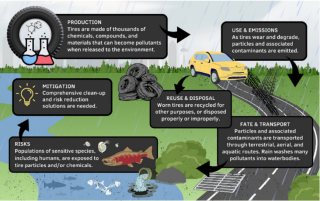
To some people, tire pollution might draw up an image of a blown-out or discarded tire on the side of a highway, or stockpiled old tires behind a garage. However, the issue of tire pollution is more complex and prolific than at first glance, as every step of a tire’s life cycle, from production to use to disposal, can impact our environment, health and wildlife.


To address growing concerns of tire pollution and a specific pollutant called 6PPD-quinone (6PPD-Q), EPA researcher Dr. Paul Mayer led an effort to investigate the life cycle of tires and their impacts on the environment. The resulting article, “Where the rubber meets the road: Emerging environmental impacts of tire wear particles and their chemical cocktails,” is a holistic examination and data compilation of tires as complex pollutants across three levels: their whole state (e.g., tire production or disposal in landfills), as particulates (i.e., as they are worn down), and as “chemical cocktails.”
The research team illustrated that the production of over 3 billion tires annually requires massive amounts of natural resources, including fossil fuels, water, and agricultural space to grow natural rubber, which has been linked to deforestation. The manufacturing process involves chemical mixtures that emit carcinogens (cancer-causing substances) and radioactive compounds. Over 800 million tires are disposed of annually and burned for fuel or broken down and recycled into products such as artificial turf infill, asphalt, landscape mulch and doormats. These processes may introduce hazards such as contact exposure to chemicals and heavy metals, inhalation, ingestion, and other risks associated with tire crumb. Further, tire piles can catch fire and burn for long periods of time, emitting harmful pollutants such as fine particulate matter (PM2.5).
The researchers found that one tire will shed between two and fourteen pounds of rubber particles due to road wear (from initial use to initial disposal). These particles may be small enough to be picked up by wind and carried for up to a month before they are deposited on land. Larger particles can be caught in stormwater runoff and transported along curbs and through stormwater systems where they are typically deposited into a local waterway. Constituents of these particles, pollutants such as microplastics, heavy metals, hydrocarbons, and other toxic chemicals can then pollute local water and soil.
The researchers also conducted a life cycle analysis of rubber tires, following one product unit from creation to disposal, identifying information gaps in tire related research along the way. The rate and volume of tire wear particle release may differ between tire brands and types. The size, shape, and surface properties of tire particles can impact the methods of their emission and transport. Further research is also needed to characterize the toxicity of tire pollutants and their health effects, including determining alternative chemicals for use in the manufacturing process and conducting longer term studies on populations of sensitive species. More accurate data on tire particle and chemical emissions based on climate, population density, and transportation infrastructure is needed to support the development of effective methods of tire pollution reduction, remediation, and risk management. These information gaps and many others identified by the research team show that tire wear particles and chemicals present a strong risk to human health and the environment, and action should be taken to research and mitigate this issue.

Several research teams across the EPA are working on addressing information gaps specifically related to the pollutant 6PPD-Q. 6PPD-Q is the product of a reaction between 6PPD, a chemical added in the tire manufacturing process, and ozone in the air. EPA-funded research in 2020 showed 6PPD-Q in stormwater to be highly toxic to several salmonid fish species and lethal to the threatened and endangered populations of coho salmon. This species is a culturally, economically, and ecologically important resource for many Tribal nations along the Pacific Northwest coast and its connected waterways. Healthy and accessible salmon populations are critical to the health and wellbeing of Tribes, including the practice and protection of Tribal Treaty Rights.
EPA ecologist Dr. Jonathan Halama is using the advanced EPA model Visualizing Ecosystem Land Management Assessments (VELMA) to learn more about the fate and transport of 6PPD-Q from tire particles in stormwater. Through the analysis of current stormwater management systems and estimated roadway deposition patterns based on traffic count data, Halama and his team are working to understand the processes influencing tire particle flow paths and to determine hotspots where 6PPD-Q is concentrated within a watershed. Using VELMA to find these 6PPD-Q hotspots can help researchers prioritize the locations and types of stormwater management designs to reduce 6PPD-Q levels most effectively.
In 2023, the EPA developed a draft analytical method to identify 6PPD-Q in surface waters and stormwater. In addition to tire life cycle analysis and stormwater management modeling, there are multiple research efforts within the EPA and in collaboration with external partners that focus on 6PPD-Q. EPA researchers are developing measurement methods for 6PPD-Q in air and sediment, tools to screen the toxicity of environmental samples, and health hazard screening values. To further protect coho salmon and other sensitive aquatic species, researchers are also investigating brake and tire emission rates of particulates, 6PPD, and metals, health effects of tire wear particles and 6PPD-Q on aquatic life, and potential alternative chemicals to 6PPD in tires.
Dr. Mayer presented about tires as complex pollutants at EPA’s Water Research Webinar on June 26th, 2024. You can watch a recording of the session here.